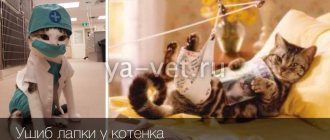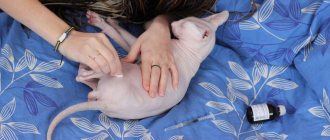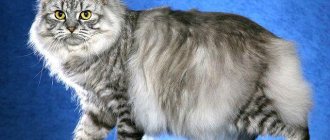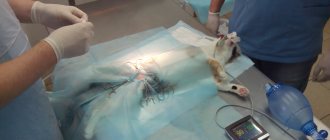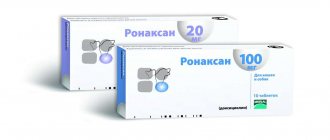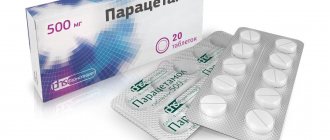Indications for use
For many, the question is relevant: is it possible to smear a cat with tetracycline ointment? After all, traditionally the drug is used to treat people. The answer to this question is affirmative - tetracycline ointment is used both in human medicine and in veterinary practice for all types of animals.
A wonderful remedy for cat eye health is Iris drops. List of the best birth control for cats. What is Duphalight needed for? —
Indications for the use of the drug are bacterial lesions of the skin:
- folliculitis,
- eczema,
- furunculosis,
- pustular skin diseases,
- prevention of wound suppuration and bacterial infections. For these lesions, an ointment with a concentration of 3% is used.
For bacterial eye infections, use the drug at a concentration of 1%. Such diseases include conjunctivitis, blepharitis, corneal burns, eye damage or foreign body entry into the eye.
About using tetracycline ointment
Tetracycline eye ointment is applied only externally to the affected areas of the skin in the form of a small drop, which must be gently rubbed.
For eye inflammation, it is placed behind the lower eyelid 2-5 times a day - it depends on the type of disease and its course. If necessary, your doctor may recommend other dosages or tetracycline-based drops (1-2 in each eye 3-4 times a day). Some instructions state that tetracycline is contraindicated in children under 8 years of age, in others up to 11. This is due to the fact that this area of use has not been studied, and the dosage for children under this age has not been determined. But pediatricians say that children should not be smeared with a 3% drug, but a 1% drug can be applied.
Reviews about the drug, of course, are different. Some parents say that only tetracycline ointment saves their children. Others are disappointed in it, since it did not help them one bit, and believe that its low price is consistent with its quality. Naturally, one drug cannot suit everyone, but doctors, including pediatricians, claim that the effectiveness of this ointment has been proven in practice.
- Pregnancy and lactation.
- Diseases of the liver, kidneys and blood.
- Individual intolerance to this component.
- nausea and vomiting;
- decreased appetite;
- intestinal upset (diarrhea or diarrhea);
- changes in the mucous membranes of the mouth and gastrointestinal tract;
- allergic reactions;
- increased skin sensitivity to the sun;
- Quincke's edema, etc.
The drug, especially 3%, should not be used to treat infants. It can cause significant darkening of tooth enamel. Treatment of newborns should be carried out under the supervision of a physician. Before using the drug on dogs or cats, you should consult your veterinarian.
If you notice any side effects in yourself or your children, dogs or cats, you should immediately stop treatment with the ointment and consult a doctor to replace it with a drug that does not contain tetracycline or eye drops. Even if their price is higher.
Antibiotics are strong drugs intended to treat inflammatory processes. Such products are also used in veterinary practice. One of the most common antibacterial agents is tetracycline ointment. For both cats and cats, it is an effective and classic remedy that is suitable for the treatment of eye diseases. So, let’s learn in detail about the ointment, its composition, features, and application.
As a rule, veterinarians prescribe this drug when diagnosing a cat with conjunctivitis, uveitis or other eye pathology caused by pathogenic microflora. Most often, doctors prescribe tetracycline ointment for the treatment of these eye ailments. Perhaps your veterinarian will recommend other, more specific remedies for treating your pet’s eyes. However, the ointment is used as the basis of therapy for almost all ophthalmic ailments.
It must be applied correctly. All veterinarian recommendations must be followed. It is important not to overdo it with the amount of medicine. For example, for the treatment of conjunctivitis in kittens, a single dose of the drug is literally the head of a pin.
Never stop using tetracycline ointment until your doctor tells you to. After all, very often the owners stop treatment at the first signs of improvement in their eye condition. And infections are insidious! If the causative agent of the disease still remains in the eyes, then a day or two after stopping the use of the ointment, it will make itself felt with renewed vigor.
It is also important to apply the medicine directly into the conjunctival cavity. There is no need to smear it over the animal’s eyelids - this way it will feel severe discomfort and wipe the medicine with its paw, then lick it off.
Therefore, it is recommended to treat a cat together. One holds the pet so that it does not escape and interfere with the procedure. The other one carefully pushes back the eyelid and puts a small amount of ointment into the conjunctival sac. This must be done with pre-washed hands. Do not press too hard on the animal's eyeball.
Typically, ointment should be used to treat eye diseases two to five times a day. This depends on the degree of development of the disease and the general condition of the pet.
It is worth knowing that no antibiotic is a 100% guarantee of an animal’s recovery. If his eye condition does not improve within three to a maximum of five days, you should consult a veterinarian. This happens when tetracycline ointment is used to treat ordinary conjunctivitis, and the disease occurs against the background of chlamydia. Therefore, it is impossible to defeat him.
When treating with tetracycline ointment, it is important not to allow the pet to lick off its remains. After all, the medicine can cause an allergic reaction that is life-threatening to the cat.
By the way, if your pet has had an allergy at least once in its life, then you need to inform your veterinarian about it. It may be necessary to do an allergy test to eliminate the risk of anaphylaxis.
During the treatment period, you need to carefully monitor the well-being of your pet.
The information posted on this page is for informational purposes only and cannot be used for self-medication!
Before using medications, consultation with a specialist is MANDATORY!
Brief description: Tetracycline ointment is an antibiotic for topical use, effective against many bacteria, pathogens of trachoma and ornithosis, and rickettsia. The main component of the drug is oxytetracycline hydrochloride. This substance suppresses protein synthesis in the microbial cell at the ribosomal level.
A 1% concentration of the drug is prescribed to animals for eye diseases - conjunctivitis, blepharitis, trachoma, infections and burns of the cornea. 3% ointment is intended for external use. It is indicated for infected wounds, burns, pustular skin diseases, folliculitis, furunculosis, eczema.
For whom: Can be used by any animal.
Dispensing form: The ointment has a uniform consistency and color from yellow to yellowish-brown. In addition to the active substance, it contains lanolin and petroleum jelly. The medicine is packaged in glass or plastic jars with a capacity of 40 g to 2 kg.
Dosage: 1% eye ointment is placed behind the animal’s lower eyelid with a sterile glass rod, and then the eyelid is lightly massaged from the outside with a cotton-gauze swab. The manipulation is repeated 3-5 times a day. After administering the ointment, you can apply a bandage to the eye. The course of treatment lasts 5-7 days. 3% tetracycline ointment is applied 1-2 times a day in a thin layer to the affected area or used as a bandage. Treatment continues until signs of the disease disappear.
Limitations: A contraindication to the drug is intolerance to tetracycline antibiotics. It is not advisable to use eye ointment simultaneously with other topical agents.
Tetracycline ointment for cats is a topical antibiotic that is effective against a wide range of bacteria. The main preparation of tetracycline ointment is the substance oxytetracycline hydrochloride. It has a bactericidal effect, suppressing the synthesis of ribosomal proteins and thereby destroying the structure of the microorganism. There is tetracycline ointment in various concentrations - 1% and 3%. It is used for external use to treat bacterial lesions.
The medicine is easy to use. The instructions recommend removing hair from the affected areas of the cat's skin before starting to use the drug. Next, you need to rinse the area, wipe dry, remove crusts and scabs. Then you need to put a muzzle on your pet. The drug must be applied with a special spatula and rubbed in.
If we are talking about the fight against lice and fleas, then you don’t have to remove the hair before using the medicine. You need to apply the drug to the skin with gloves, spreading the fur - this way the cat will not be able to lick it off.
When it comes to signs of disease in the ears, they must first be wiped with alcohol, then massaged, and only then treated with medicine.
In case of entomosis, that is, detection of fleas, lice, and lice in a cat, it is recommended to rub the ointment against the growth of the fur. For ease of use, you can heat it in a water bath and use it warm.
We invite you to familiarize yourself with: Latest added Bearded Collies - Bearded Collie Pedigree Database
Some pets may have allergic reactions to aversictin ointment. Therefore, it is necessary to know when the medicine should not be used to treat cats. This is a period of infectious diseases, cat pregnancy, state of exhaustion, lactation, animal age up to two months, individual intolerance to aversectin C.
As practice shows, the drug is in most cases well tolerated by pets. Allergies can manifest as bouts of vomiting, skin irritation, and rashes. If the owner notices such signs, then you need to stop using the ointment.
So, cats sometimes behave nervously and restlessly. The reason for this behavior may be parasites. If they are detected, it is necessary to use aversectin ointment.
If your pet has uveitis, conjunctivitis or another eye pathology that is caused by pathogenic microflora, you will probably have to smear the cat's eyes with tetracycline ointment. Of course, your veterinarian (and you can’t do without a visit to him) will probably prescribe more specific medications, but this particular medicine is used for almost any ophthalmological disease.
Instructions for use and dosage
Tetracycline ointment is effective for bacterial eye infections.
So the veterinarian prescribed tetracycline ointment. How to smear it correctly and what is the dosage? This depends, first of all, on the nature of the damage, the degree of its severity and the percentage of the drug in the ointment. For example, a medicine with 1% should be applied to previously cleaned damaged areas 3-5 times a day, and with 3% - 1-2 times a day.
It is important to ensure that the cat does not lick the drug off itself.
If you need to treat the eye, you should try to place the ointment behind the eyelid with a sterile glass rod, and then lightly massage the eyelid from the outside. The course of treatment with the drug is usually 5-7 days. The veterinarian reports this more specifically - most often the drug is used until the signs of the disease completely disappear. Do not forget that the drug is an antibiotic and should be used with caution.
What is the drug
Tetracycline eye ointment is a complex antibiotic that is available in metal tubes. Tetracycline ointment has a thick consistency and a uniform light yellow color.
© shutterstock
Properties of tetracycline substance:
- antiseptic;
- anti-inflammatory;
- antibacterial.
In addition, the drug has a prolonged effect. The main substance tetracycline in the ointment is considered a universal antibiotic and a highly effective component in the fight against gram-positive and gram-negative pathogenic microorganisms and fungi.
Side effects and contraindications
The ointment rarely causes an allergic reaction.
It is not advisable to use the drug simultaneously with other antiseptics for external use. Also, the ointment should not be used on those animals that are intolerant to tetracycline antibiotics. In addition, before using the drug, it is advisable to carry out an analysis to identify the type of pathogen, because this antibiotic is effective against a limited number of them.
No side effects were identified when using the drug, however, with prolonged or too frequent use, dryness or local irritation of the skin may occur.
Medicines for animals {amp}gt; Tetracycline ointment
The domestically produced medicine is intended to combat external parasites - fleas, ticks, lice eaters. It is easy to use and affordable. The veterinary drug is used to treat not only cats, but also parrots, dogs, and rabbits. The ointment contains aversectin C. It is this substance that provides the main therapeutic effect. The auxiliary components of the drug are glycerol (distilled glycerin), polyethylene oxide.
The ointment belongs to the category of insectoacaricidal drugs. It effectively eliminates mature and larval Demodex mites, sarcoptic mites, and lice mites. Indications for the use of aversectin ointment also include sarcoptic mange, otodectosis, entomosis, and notoedrosis.
Aversectin C has the property of penetrating the nerve and muscle cell membranes of parasites, causing their paralysis and then death. When treating the affected skin of a cat, the medicine penetrates the skin in places where parasites are most concentrated and has an insectoacaricidal effect. It takes 3 to 5 days to use the ointment for its plasma concentration to reach its maximum level. And after 10 days, the main active ingredient of the medicine is removed from the cat’s body.
Aversectin ointment does not have a negative effect on the health of the pet. It does not produce mutagenic, teratogenic, irritating effects characteristic of similar drugs. The drug does not cause such side effects even with long-term use. But it is forbidden to use it to treat people.
The medicine is produced in polymer jars. Its shelf life is two years.
Reviews from veterinarians
Marina, 45 years old. “Tetracycline ointment is a long-proven remedy for the prevention of wound suppuration. I use it to treat burns and treat skin infections. I am satisfied with the product because of its reliability and low cost.”
Oleg, 32 years old. “I think that tetracycline ointment has outlived its usefulness as an antibiotic, because Now there are many strains of bacteria that have become resistant to it. In addition, due to its consistency, the processing process is not always convenient; animals often lick it off. There are more modern and convenient means.”
ABOUT VACCINATIONS
Before any vaccinations, the animal MUST undergo flea and worm treatment!
Rabies is a 100% fatal disease. All species of mammals and humans are susceptible to it. Therefore, rabies vaccination is required for all pets.
Don't forget about vaccination. There are a huge number of preventive vaccinations, but we prefer the NOBIVAK Tricat vaccine (live lyophilized vaccine against viral rhinotracheitis, calicivirus infection and feline viral panleukopenia) and NOBIVAK Rabies (against rabies), Holland. We remind you that vaccine developers recommend the optimal vaccination schedule for each vaccine.
If you are not a veterinarian, do not make any adjustments and follow what is written in the instructions or what your veterinarian says. The first vaccinations are given to kittens twice. Immunity is developed only 14 days after the second vaccination. And keep in mind that during the month and a half that the vaccination schedule is in progress, the kitten’s body weakens.
WHAT MEDICINES IS IT DESIRABLE TO HAVE IN A CAT'S HOME MEDICINE KIT?
Let's tell you in order. For any parents, the hardest time is when their baby is sick. In this case, the kitten, cat or cat is our child. We are losing peace and sleep, we are ready to share his illness with the baby, to take it upon ourselves, if it were possible, we are ready to do anything to ensure that our treasure recovers quickly and becomes cheerful and happy again. The kitten cannot tell where it hurts and how. Only suddenly he gets sick. This is where essential medications come to the rescue.
This is the kind of “cat first aid kit” you need to have at home in order to provide first aid yourself before the veterinarian arrives. Attention! In mild cases, I am not focusing your attention on this, you can cope on your own, especially since veterinary services are oh so expensive, and not always of high quality, to be honest.
- in case of cuts, bites, if the wound is not lacerated, treat with 3% HYDROGEN PEROXIDE. In the future, if the wound gets wet, treat it again with peroxide and sprinkle with dry STREPTOCIDE (as an anti-inflammatory disinfectant). If the wound cracks, lubricate it with SYNTHOMYCIN EMULSION. If the wound festers, then the well-known VISHNEVSKY OINTMENT will help us all.
In case of severe fatigue, heat stroke, heart failure, and weakness of breathing, you can give heart medications: Corvalol, Valocordin, etc. It is even better to give an injection of SULPHOCAMPHOCAINE.
For general mild malaise and lethargy, we inject our patients with IMMUNOFAN. It stimulates the body's vital resources and helps it cope with the disease faster. There is also a drug called BAYPAMUN from Bayer. It is also a nonspecific stimulator of the body's own defenses. It is an effective prevention of the effects of stress caused by transportation, exhibition, and hospital stay.
If vomiting appears and the stool suddenly deteriorates, then you need to stop feeding altogether (at least for one day), give plenty of fluids with a weak pale pink solution of POTASIUM MANganese and 1-2 tablets of ACTIVATED CHARCOAL. In addition, rice water and chicken broth diluted with water are very helpful. We definitely give 1/2 tablet of SULGIN 2 times a day, and if the stool does not improve within 24 hours, then we begin to give stronger and more effective remedies.
In general, symptoms of diarrhea, and even more so if they are accompanied by vomiting, are the worst and most unpleasant symptom. If a day after the first symptoms appear the kitten does not feel better, if there is also vomiting and it does not stop, then there is only one piece of advice - immediately contact a veterinarian. This can be very life-threatening poisoning, hepatitis, feline enteritis (panleukopenia), etc. The main thing here is not to be late.
Another problem is constipation, which is also unpleasant. In this case, gentle laxatives are needed. This can be milk, vegetable oil (a teaspoon), and a very effective remedy is Vaseline oil (a tablespoon).
If your eyes are red or watery, or there is a speck of dirt in your eye, or there is a slight injury to your eye, we use TETRACYCLINE OINTMENT, which is placed behind the eyelid three to four times a day. If it doesn't get better after a week, go to the vet. There is also a whole list of eye drops listed below.
Deworming is a very necessary thing for our pets. If there are children in families, this is a must. Once a quarter we give a kitten, a cat or a cat antihelminthic drugs, we ourselves always use only DRONTAL for cats, 1 tablet per 4 kg of weight, Bayer. The drug contains praziquantel and pyrantel embonate, so it kills both roundworms and tapeworms.
Don't forget about ticks and fleas. For cats that go outdoors in the summer, as well as for cat owners who also have a dog, it is still better not to neglect such drugs, but to use them constantly. Since fleas are carriers of many infections, eggs and larvae of worms. We use a drug such as “Advantage” (drops) from Bayer.
This wonderful drug is good because it is not absorbed into the blood, spreads over the skin and kills up to 98% of all fleas, their larvae and eggs within 12 hours. And the best thing is that this drug can be used for pregnant and lactating cats; it does not affect pregnancy. In addition, the drug has an umbrella effect, that is, if the mother cat is treated, then baby kittens up to 8 weeks of age also do not become infected with fleas. An analogue may be the drug "Frontline"
If the kitten is still sick or has caught an infection, then of course you need to contact the breeder and the doctor, but know that there are good medications, such as BAYTRIL - a broad-spectrum antibiotic. It is used in the treatment of infectious diseases. Now Russian developers produce many domestic drugs, which also help us, animal owners, a lot. The drug FOSPRENIL is a very effective remedy for the prevention and treatment of viral infections in cats and dogs.
And, of course, the main thing is proper balanced nutrition.
Customer Reviews
Valentina, 22 years old. “Tetracycline ointment was prescribed by a veterinarian to treat a festering wound on a cat. I had to seriously struggle with applying bandages, because... the cat constantly tried to lick it off. In general, the product is cheap and effective, but it has its own nuances.”
Maria, 34 years old. “We treated a cat’s conjunctivitis with tetracycline ointment. Putting the ointment behind the eyelid was practically beyond fantasy, and after a few minutes it was gone, because the cat was constantly rubbing his eye with his paw, which irritated him even more. We switched to antibiotic drops and cured the eye much faster and more conveniently.”
In the video, a veterinarian shows how to put ointment in a cat's eye:
Cat eye care
Healthy cat eyes do not require special care. You just need to periodically inspect them and, if necessary, wipe them with damp cotton wool; this will help prevent dangerous diseases.
Some breeds of cats, for example, Persian or exotic, often have watery eyes due to the characteristics of the tear ducts. The eyes of such cats require daily care. It is advisable to clean the corners of the eyes with a small damp cloth, but you can also use cotton wool. Take a cloth, moisten it with warm boiled water or chamomile decoction, you can also use special drops or Optic gel, then wipe the eye and fur underneath it.
Use a different cloth for each eye. If your cat's eyelashes stick together, you need to carefully run a damp swab along their outer surface, from the nose to the corner of the eye. Do this until your eyes open and close freely. After this, rinse the eyeball (drop liquid onto its surface) and finally dry the skin around the eyes. Do not touch the surface of the eye with dry material - it will stick and when you detach it, it will remove the top layer of cells.
It happens that cats develop tear stones. Because of it, yellowness appears on the fur, it is very difficult to get rid of it. You can use a special remedy for tear stone or resort to another cunning trick. Take tweezers and carefully pull out the yellow hairs one at a time and not all at once.
Healthy cat eyes are clear and wide open. If the third eyelid (nictitating membrane) protrudes from the corner of the eye and partially covers the eye, this may be a sign of fever or infection, sometimes due to intestinal problems. The appearance of a third eyelid in only one eye indicates problems with that particular eye.
Increased lacrimation (especially if the tears are cloudy and brown), swelling of the eyelid or redness of the eyes indicate the presence of a respiratory disease. In such cases, it is better to consult a doctor.
For severe inflammation of the eyes, it is recommended to use a solution of chloramphenicol or tetracycline eye ointment. Drop chloramphenicol into your cat's eyes 5 times a day for 10 days. Apply tetracycline ointment at night. The ointment flows much easier if it is preheated. Pull the lower eyelid down and squeeze a little ointment onto the surface of the eyelid.
If anything unusual appears in the eyes (the cat rubs them with its paw, squints, blinks frequently) or a foreign body that cannot be removed, contact your veterinarian immediately.
CAT HOME MED KIT
It is always advisable to have the necessary set of medications and tools at home or take it with you if you take your cat with you on a trip.


